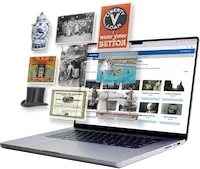The Role of Technology in Archives
Margot Note
Technology is pivotal in enhancing digital preservation efforts in this digital age. Technology ensures the integrity of digital materials, facilitates engagement, and streamlines workflows for archivists.
The core objective of digital preservation is to prevent technological obsolescence, ensuring that digital materials remain accessible over time. Archivists leverage technology to migrate digital materials to newer formats, mitigating the risks of changing technologies. This proactive approach safeguards the longevity and accessibility of historical resources.
One of the remarkable ways technology contributes to the field of archiving is by enabling remote access to archival materials. Archivists recognize the importance of breaking down geographical barriers to provide stakeholders access to historical resources. Through online platforms, archivists make digitized materials accessible, fostering engagement regardless of the user’s location.
Utilizing Tools
Technology has opened new avenues for engagement through social media platforms, blogs, podcasts, and other digital tools. Archivists leverage these platforms to reach a wider audience, sharing fascinating finds from the archives, highlighting their work, and initiating meaningful conversations about history.
As technology evolves, archivists find themselves at the intersection of preserving historical records and adapting to the dynamic digital landscape. The accessibility and immediacy offered by social media platforms enable archivists to connect with diverse audiences instantaneously. Tweets, Instagram posts, and Facebook updates can provide glimpses into historical treasures, creating a virtual bridge between the past and present. Podcasts and blogs further amplify their ability to narrate compelling stories, offering a more immersive experience for enthusiasts curious about the intricacies of archival work. This shift towards digital engagement broadens the reach of archival content. It fosters a sense of community involvement in preserving and appreciating shared history.
However, as archivists embrace these technological advancements, they also grapple with the challenges of digital preservation. The rapid pace of innovation means that formats and platforms become obsolete, raising concerns about the long-term accessibility of digital records. Archivists must navigate the complexities of ensuring that the valuable records they curate today remain accessible and intact for future generations. As custodians of history in both the physical and digital realms, this dual role underscores the evolving nature of archival practices in the contemporary era.
Streamlining Workflows
The integration of technology has revolutionized the way archivists manage their workflows. Digital tools play a crucial role in automating repetitive tasks, allowing archivists to redirect their focus toward more complex and intellectually demanding aspects of their work. Optical character recognition (OCR) software automates transcription processes, and machine learning algorithms categorize archival materials efficiently, saving time and resources.
In the age of technology, archivists serve as the bridge between the past and the present. Archivists engage stakeholders with historical materials and create a dynamic ecosystem where historical knowledge informs current projects. This interaction fosters a deeper understanding of the organization’s rich history, making it an integral part of its narrative.
As archivists embrace technology as a conduit for engagement, they contribute to a culture where an organization’s history is archived. This utilization becomes a driving force for success in the future. Historical insights gained through technology-driven archival practices provide valuable perspectives that guide decision-making and inspire organizational innovation.
Technology has become an indispensable tool for archivists, enhancing digital preservation, facilitating remote access, and streamlining workflows. By embracing technology, archivists not only ensure the accessibility of historical resources but also engage with the public, contributing to a culture where the past is a vibrant part of the present and a catalyst for future success. The marriage of technology and archiving is a testament to the evolving nature of preserving the rich cultural heritage in the digital era.
Margot Note
Never miss another post. Subscribe today!
Similar Posts
Improving Collection Management Through Archival Surveys
Archival surveys are powerful tools for improving collection management. By surveying collections, archivists can gather essential data that inform preservation, access, and resource allocation.
Texas Archive of the Moving Image: Interview with the Digital Archivist
I recently interviewed Grace Muñoz about her work at the Texas Archive of the Moving Image. Her work on improving the discoverability of the multimedia collection is fascinating.
How to Conduct Comprehensive Archival Surveys
Conducting a comprehensive archival survey is critical to successfully managing archival collections.
Remembering History, Moving Forward Together, with ArchivEra
The Catholic Diocese of Arlington’s Director of Archives selected ArchivEra to manage their collections of historical and cultural significance, and strike a balance between security and access.





Leave a Comment
Comments are reviewed and must adhere to our comments policy.
0 Comments